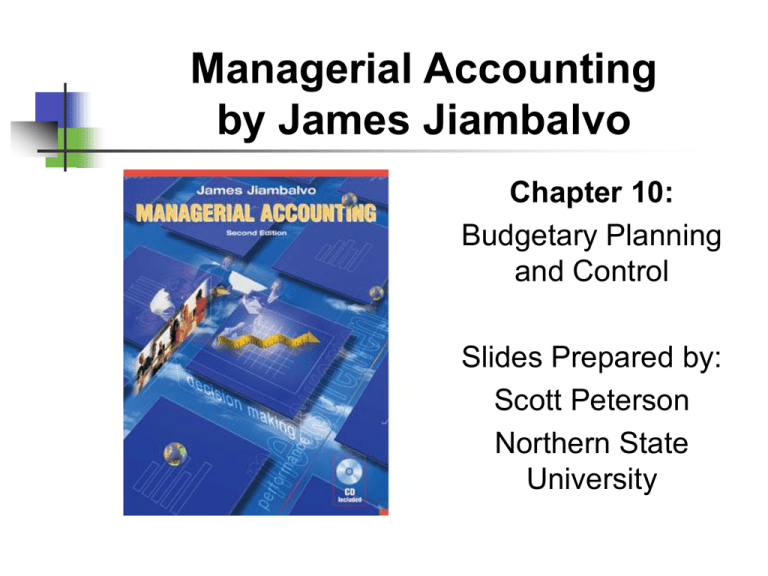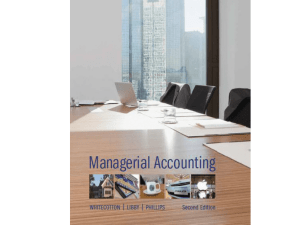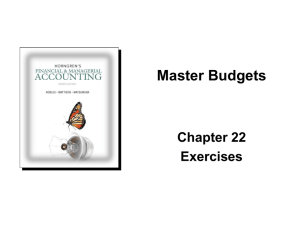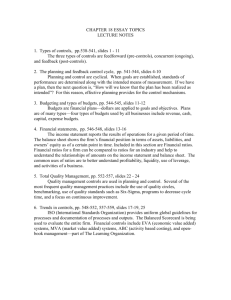
Managerial Accounting
by James Jiambalvo
Chapter 10:
Budgetary Planning
and Control
Slides Prepared by:
Scott Peterson
Northern State
University
Objectives
1. Discuss the use of budgets in planning
and control.
2. Prepare the budget schedules that
make up the master budget.
3. Explain why flexible budgets are
needed for performance evaluation.
4. Discuss the conflict between the
planning and control uses of budgets.
Use of Budgets in Planning
and Control
1. The entire planning and control
process of many companies is built
around budgets.
Planning
1. Budgets are useful because they
enhance:
a. Communication.
b. Coordination.
2. The process of developing a budget
forces managers to consider:
a. Goals.
b. Objectives.
c. Specify means of achieving them.
Control
1. Budgets are useful because they
provide a basis for evaluating
performance.
2. Performance evaluation is carried out
by comparing actual performance with
planned or budgeted performance.
3. Significant deviations from planned
performance are associated with three
potential causes.
Control: Significant Deviations
From Planned Performance Are
Associated With
1. Poorly conceived budgets.
2. Business conditions may have
changed.
3. Managers that have done a particularly
good or bad job managing operations.
Role of Budgets in Planning
and Control Process
Developing the Budget
1. Budgets are prepared for
a. Departments.
b. Divisions.
c. Company as a whole.
2. The Budget Committee is responsible for
approval of the budget:
a.
b.
c.
d.
e.
Senior managers
President
CFO
Various vice-presidents
Controller.
Developing the Budget
(Continued)
3. Top-down approach is where goals are
pushed down from top management.
4. Bottom-up approach is where lowerlevel managers are the primary source
of information used in setting the budget.
Budget Time Period
1. Budgets range from months to several
years or more.
2. Key point is that there is an inverse
relationship between”
a. Length of the budget period.
b. Detail contained within the budget.
Zero Base Budgeting
1. Zero Base Budgeting (ZBB) is a method
of budget preparation which begins each
period with a clean slate.
2. Managers must start from zero and
justify budgets every period.
3. Used in government budgeting.
4. Not commonly used in business.
The Master Budget
Master Budget (comprehensive) Includes:
1. Sales budget.
2. Production budget.
3. Direct materials budget.
4. Direct labor budget.
5. Manufacturing overhead budget.
6. Selling and administrative budget.
The Master Budget
Master Budget Includes:
7. Capital acquisitions budget.
8. Cash receipts and disbursements
budget.
9. Budgeted income statement.
10. Budgeted balance sheet.
The Master Budget: Graphic
Sales Budget
1. Sales budget is the first step in the
budget process.
2. It comes first because other budgets
cannot be prepared without an estimate
of sales.
3. Example: production estimates are
based on forecast sales.
Sales Budget
(Continued)
4. Companies use a variety of methods to
estimate sales:
a. Econometric models.
b. Previous sales trends.
c. Trade journals and magazines.
d. Sales force estimates.
Production Budget
Production forecasts are based on the
following relationships:
Finished units to be produced
=
expected sales in units
+
desired ending inventory of finished units
–
beginning inventory of finished units
Direct Material Purchase
Budget
1. Direct materials budgets depend on:
a. The amount needed for production
b. The amount need for ending
inventory.
Direct Material Purchase
Budget
(Continued)
2. Calculated as follows:
Required purchases of direct materials
=
amount required for production
+
desired ending inventory of direct materials
–
beginning inventory of direct materials
Direct Labor Budget
Direct labor budget calculated by
multiplying:
Number of units to be produced
x
Labor hours per unit
x
rate per hour
Manufacturing Overhead
Budget
1. Cost per unit of production of each
variable cost item is multiplied by the
quantity of units produced.
2. Fixed costs remain relatively constant.
Selling and Administrative
Expense Budget
Selling and administrative expense budgets
include:
1. Salaries.
2. Advertising.
3. Office expenses.
4. Other general expenses.
Budgeted Income Statement
1. Sales figures come from the sales
budget.
2. Cost of goods sold is based on unit cost
of production (and the direct materials
budget).
3. Labor cost information comes from the
direct labor budget.
4. Overhead cost information is provided
by the manufacturing overhead budget
provides.
Capital Acquisitions Budget
1. Acquisitions of capital assets such as:
a. Property.
b. Plant
c. Equipment.
2. Must be carefully planned because they
consume substantial cash reserves.
Cash Receipts and
Disbursements Budget
1. Managers plan for the
a. Amount of cash flows and the
b. Timing of cash flows.
2. VERY important budget because...
3. The timing of cash inflows and outflows
may diverge substantially from the
income statement.
Budgeted Balance Sheet
1. The last component of the master
budget.
2. A function of all of the other budgets.
3. Sometimes referred to as a pro-forma
balance sheet.
4. Used to assess the effect of planned
decisions on future financial position.
Use of Computers in The
Budget Planning Process
1. Computers are very useful in the
preparation of budgets.
2. Spreadsheets, like Excel or Lotus 1-2-3,
are very effective in modeling budget
relationships.
3. Spreadsheets allow for “what if”
analysis:
a. What if direct labor increases to $14.45
b. What if fixed factory overhead decreases
by 3.5%…
Budgetary Control
1. In addition to:
a. Planning
b. Communicating goals
c. Coordinating activities
2. Budgets also facilitate control of
operations.
Budgets as A Standard For
Evaluation
1. Budgets facilitate control by providing a
standard for evaluation.
2. The standard is the budgeted amount
against which actual results are
compared.
3. Differences between budgeted and
actual amounts are called budget
variances.
4. Material differences between actual and
budgeted should investigated.
Static and Flexible Budgets
1. Make sure that the level of activity used
in the budget is equal to the actual level
of activity.
2. Production budgets are a function of
planned sales.
3. If sales suddenly, production must
increase to meet demand , thus total
variable production costs will rise.
Static and Flexible Budgets
4. A static budget is not adjusted for the
actual level of production and is not
suited for performance measurement.
5. A flexible budget is a set of budget
relationships that can be adjusted to
various activity levels. It is suited for
performance measurement.
Investigating Budget Variances
1. Variances may have three causes:
a. May be ill conceived
b. Conditions have changed
c. Job performance
2. Variances should be investigated.
3. Management by exception is an
approach that is economical and often
used.
4. Only exceptional variances are
investigated.
Conflict in Planning and
Control Uses of Budgets
1. Conflict is inherent in the planning and
control uses of budgets.
2. Result is that managers:
a. Pad their budgets.
b. Shift income between accounting
periods to increase their
compensation.
Why Budget-Based Compensation
Can Lead To Budget Padding and
Income Shifting
1. Hurdle bonuses and variable bonuses
are commonly used.
2. Two problems:
a. Managers have an incentive to “pad”
their budgets resulting in “slack”
budgets that are easy to achieve.
b. Managers have an incentive to shift
income from one accounting period
to another to achieve “hurdle”
targets.
Evaluation, Measurement, and
Management Behavior
1. Managers pay close attention to how
their performance is measured and
evaluated.
2. Budgets are usually measured in dollars
and cents.
3. Some types of non-monetary measures
of performance are likely to be
advantageous.
4. “You Get What You Measure!”
Quick Review Question #1
1. Which of the following items do not
requre a cash outflow?
a. Salaries.
b. Purchase of raw material.
c. Advertising.
d. Depreciation.
Quick Review Answer #1
1. Which of the following items do not
requre a cash outflow?
a. Salaries.
b. Purchase of raw material.
c. Advertising.
d. Depreciation.
Quick Review Question #2
2. Which of the following comes last in
the budget process.
a. Sales budget.
b. Cash receipts/disbursements
budget.
c. Budgeted balance sheet.
d. Production budget.
Quick Review Answer #2
2. Which of the following comes last in
the budget process.
a. Sales budget.
b. Cash receipts/disbursements
budget.
c. Budgeted balance sheet.
d. Production budget.
Quick Review Question #3
3. The difference between a budgeted
and actual amount is called
a. An error.
b. A flexible budget.
c. A variance.
d. Fraud.
Quick Review Answer #3
3. The difference between a budgeted
and actual amount is called
a. An error.
b. A flexible budget.
c. A variance.
d. Fraud.
Quick Review Question #4
4. Beginning inventory is 3,200 units.
Required ending inventory is 3,500
units. Sales are forecasted at 14,500
units. The production budget calls for
how many units?
a. 21,200
b. 14,200
c. 14,800
d. Cannot be determined
Quick Review Answer #4
4. Beginning inventory is 3,200 units.
Required ending inventory is 3,500
units. Sales are forecasted at 14,500
units. The production budget calls for
how many units?
a. 21,200
b. 14,200
c. 14,800
d. Cannot be determined
Copyright
© 2004 John Wiley & Sons, Inc. All rights reserved.
Reproduction or translation of this work beyond that
permitted in Section 117 of the 1976 United States
Copyright Act without the express written permission of the
copyright owner is unlawful. Request for further information
should be addressed to the Permissions Department, John
Wiley & Sons, Inc. The purchaser may make back-up
copies for his/her own use only and not for distribution or
resale. The Publisher assumes no responsibility for errors,
omissions, or damages, caused by the use of these
programs or from the use of the information contained
herein.






